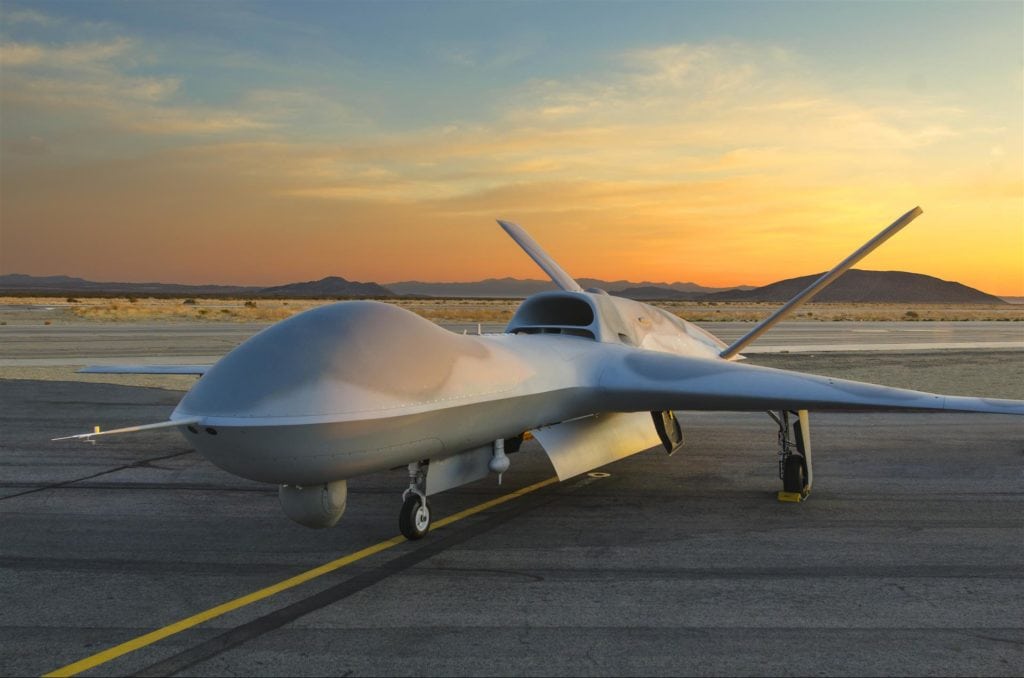
A General Atomics Predator drone. U.S. Customs and Border Protection has a fleet of Predators that patrol land and maritime borders for homeland security missions. Photo courtesy General Atomics
The U.S. Coast Guard has issued a draft solicitation related to a forthcoming technology demonstration of long-range, ultra-endurance unmanned aircraft systems (UAS) for potential use finding and tracking illegal drug and migrant activities in the transit zone.
The technology demonstration will help the Coast Guard determine the operational utility of long-range, ultra-endurance UAS for patrolling the transit zone.
Awards will be made during fiscal year 2018 and the demonstrations will be held in fiscal year 2019, a Coast Guard spokeswoman told Defense Daily. The draft solicitation and attached statement of work are intended to give industry a chance to comment or ask questions about the Coast Guard’s plans and requirements for the long-range UAS. The final solicitation for the technology demonstration is slated for release April 13.
Congress in fiscal year 2017 appropriated $18 million for the Coast Guard to test and evaluate long-range, ultra-endurance UAS for intelligence, surveillance and reconnaissance missions in the source and transit zones. The transit zone, which encompasses the eastern Pacific Ocean, Caribbean Sea and the Gulf of Mexico, is typically where illegal drugs originating in South America are carried in bulk on ships before being offloaded in Central America and broken down into smaller packages for shipment by vehicles and small vessels into the U.S. Once the drugs make land they are divided into smaller parcels and then are harder to detect.
The Coast Guard wants to deploy the long-range, ultra-endurance UAS to bolster its assets used for patrolling the transit zone. The statement of work, released March 26, said minimum performance requirements include 24-hour endurance, operations at a 15,000-foot mean above sea level and various maritime sensors, including electro-optic and infrared full-motion video, surveillance radar, radio frequency and direction finding, and tactical communications radio and datalink.
The Coast Guard has been conducting operational assessments of small UAS aboard one of its high-endurance National Security Cutters, the Stratton, finding success in aiding the interdiction of small “go-fast” boats that smugglers sometimes use to rapidly move drugs from Colombia to an offload point. The service has used Boeing’s ScanEagle small UAS, which can remain airborne for up to 12 hours, in the shipboard demonstrations.
In February, the Coast Guard released a request for proposals for small UAS to be used aboard its entire fleet of NSCs. The solicitation is for commercially-acquired ISR services. The Coast Guard has nine NSCs that have either been delivered or are under contract and last month awarded shipbuilder Huntington Ingalls Industries a long-lead-time materials contract for the 10th 418-foot cutter. The program of record was for eight NSCs but Congress, which recently provided full funding for the 10th and 11th vessels, may fund a 12th, which would equal a one-for-one replacement of the retiring Hamilton-class high endurance cutters.
The Coast Guard is also conducting an analysis of alternatives for the systems and equipment that could be used in patrolling the transit zones by air.
The contractor selected for the long-range UAS technology demonstration will also be required to provide a ground control station and equipment support package. For the evaluation, the UAS system will be based at Eglin Air Force Base in Florida.
The Coast Guard has said it would hope to deploy a long-range UAS at a U.S. installation in Central America.
The Coast Guard has some experience with long-range UAS through Customs and Border Protection’s (CBP) fleet of nine MQ-9 Predator B drones supplied by General Atomics. CBP’s fleet flies from airfields in Arizona and Texas and includes two maritime variants, called Guardian, that patrol maritime border areas. The Coast Guard contributes pilots for the CBP Predator B operations, which also aid in Coast Guard missions.
This was originally published at Defense Daily.